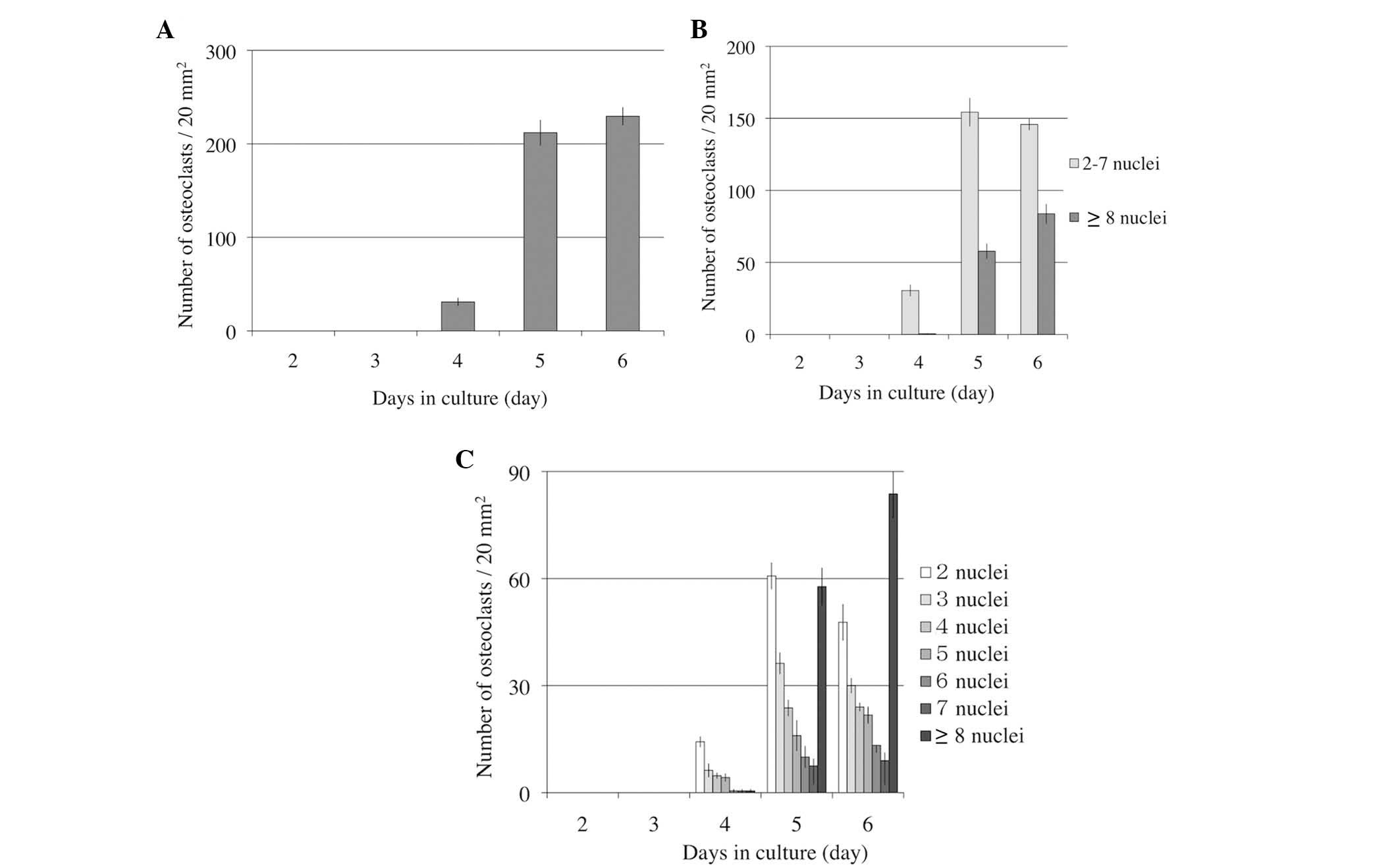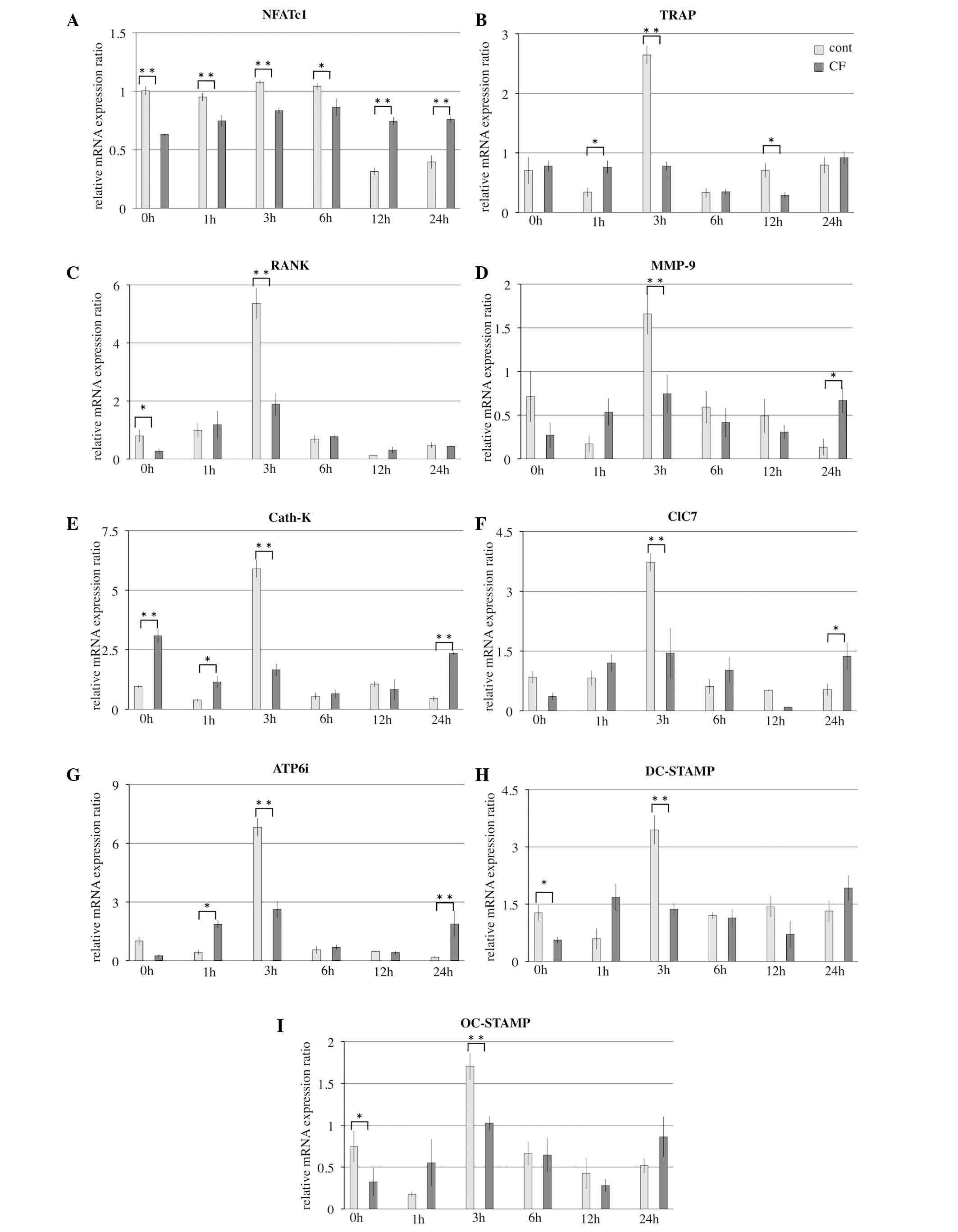|
1
|
Karsenty G and Wagner EF: Reaching a
genetic and molecular understanding of skeletal development. Dev
Cell. 2:389–406. 2002. View Article : Google Scholar : PubMed/NCBI
|
|
2
|
Teitelbaum SL and Ross FP: Genetic
regulation of osteoclast development and function. Nat Rev Genet.
4:638–649. 2003. View
Article : Google Scholar : PubMed/NCBI
|
|
3
|
Roberts-Harry D and Sandy J: Orthodontics.
Part 11: Orthodontic tooth movement. Br Dent J. 196:391–394. 2004.
View Article : Google Scholar : PubMed/NCBI
|
|
4
|
Bourauel C, Vollmer D and Jäger A:
Application of bone remodeling theories in the simulation of
orthodontic tooth movements. J Orofac Orthop. 61:266–279. 2000.(In
English, German). View Article : Google Scholar : PubMed/NCBI
|
|
5
|
Boyle WJ, Simonet WS and Lacey DL:
Osteoclast differentiation and activation. Nature. 423:337–342.
2003. View Article : Google Scholar : PubMed/NCBI
|
|
6
|
Takayanagi H: The role of NFAT in
osteoclast formation. Ann N Y Acad Sci. 1116:227–237. 2007.
View Article : Google Scholar : PubMed/NCBI
|
|
7
|
Zhang F, Wang CL, Koyama Y, Mitsui N,
Shionome C, Sanuki R, Suzuki N, Mayahara K, Shimizu N and Maeno M:
Compressive force stimulates the gene expression of IL-17s and
their receptor in MC3T3-E1 cells. Connect Tissue Res. 51:359–369.
2010. View Article : Google Scholar : PubMed/NCBI
|
|
8
|
Shibata K, Yoshimura Y, Kikuiri T,
Hasegawa T, Taniguchi Y, Deyama Y, Suzuki K and Iida J: Effect of
the release from mechanical stress on osteoclastogenesis in
RAW264.7 cells. Int J Mol Med. 28:73–79. 2011.PubMed/NCBI
|
|
9
|
Kameyama S, Yoshimura Y, Kameyama T,
Kikuiri T, Matsuno M, Deyama Y, Suzuki K and Iida J: Short-term
mechanical stress inhibits osteoclastogenesis via suppression of
DC-STAMP in RAW264.7 cells. Int J Mol Med. 31:292–298.
2013.PubMed/NCBI
|
|
10
|
Hayakawa T, Yoshimura Y, Kikuiri T,
Matsuno M, Fukushima K, Shibata K, Deyama Y, Suzuki K and Iida J:
Optimal compressive force accelerates osteoclastogenesis in
RAW264.7 cells. Mol Med Rep. 12:5879–5885. 2015.PubMed/NCBI
|
|
11
|
Suzuki N, Yoshimura Y, Deyama Y, Suzuki K
and Kitagawa Y: Mechanical stress directly suppresses osteoclast
differentiation in RAW264.7 cells. Int J Mol Med. 21:291–296.
2008.PubMed/NCBI
|
|
12
|
Rubin J, Murphy TC, Fan X, Goldschmidt M
and Talor WR: Activation of extracellular signal-regulated kinase
is involved in mechanical strain inhibition of RANKL expression in
bone stromal cells. J Bone Miner Res. 17:1452–1460. 2002.
View Article : Google Scholar : PubMed/NCBI
|
|
13
|
Koike M, Shimokawa H, Kanno Z, Ohya K and
Soma K: Effects of mechanical strain on proliferation and
differentiation of bone marrow stromal cell line ST2. J Bone Miner
Metab. 23:219–225. 2005. View Article : Google Scholar : PubMed/NCBI
|
|
14
|
Kanzaki H, Chiba M, Sato A, Miyagawa A,
Arai K, Nukatsuka S and Mitani H: Cyclical tensile force on
periodontal ligament cells inhibits osteoclastogenesis through OPG
induction. J Dent Res. 85:457–462. 2006. View Article : Google Scholar : PubMed/NCBI
|
|
15
|
Nishijima Y, Yamaguchi M, Kojima T, Aihara
N, Nakajima R and Kasai K: Levels of RANKL and OPG in gingival
crevicular fluid during orthodontic tooth movement and effect of
compression force on release from periodontal ligament cells in
vitro. Orthod Cranifac Res. 9:63–70. 2006. View Article : Google Scholar
|
|
16
|
Ichimiya H, Takahashi T, Ariyoshi W,
Takano H, Matayoshi T and Nishihara T: Compressive mechanical
stress promotes osteoclast formation through RANKL expression on
synovial cells. Oral Surg Oral Med Oral Pathol Oral Radiol Endod.
103:334–341. 2007. View Article : Google Scholar : PubMed/NCBI
|
|
17
|
Liu J, Zhao Z, Zou L, Li J, Wang F, Li X,
Zhang J, Liu Y, Chen S, Zhi M and Wang J: Pressure-loaded MSCs
during early osteodifferentiation promote osteoclastogenesis by
increase of RANKL/OPG ratio. Ann Biomed Eng. 37:794–802. 2009.
View Article : Google Scholar : PubMed/NCBI
|
|
18
|
Rubin J, Biskobing D, Fan X, Rubin C,
McLeod K and Taylor WR: Pressure regulates osteoclast formation and
MCSF expression in marrow culture. J Cell Physiol. 170:81–87. 1997.
View Article : Google Scholar : PubMed/NCBI
|
|
19
|
Mehrotra M, Saegusa M, Wadhwa S,
Voznesensky O, Peterson D and Pilbeam C: Fluid flow induceds RANKL
expression in primary murine calvarial osteoblasts. J Cell Biochem.
98:1271–1283. 2006. View Article : Google Scholar : PubMed/NCBI
|
|
20
|
Tan SD, Vries TJ, Kujipers-Jagtman AM,
Semeins CM, Everts V and Klein-Nulend J: Osteocytes subjected to
fluid flow inhibits osteoclast formation and formation and bone
resorption. Bone. 41:745–751. 2007. View Article : Google Scholar : PubMed/NCBI
|
|
21
|
Hong Z Qing, Tao L Meng, Yi Z, Wei L, Ju
Xiang S and Li L: The effect of rotative stress on CAII, FAS, FASL,
OSCAR, and TRAP gene expression in osteoclasts. J Cell Biochem.
114:388–397. 2013. View Article : Google Scholar : PubMed/NCBI
|
|
22
|
Makihira S, Kawahara Y, Yuge L, Mine Y and
Nikawa H: Impact of the microgravity environment in a 3-dimentional
clinostat on osteoblast- and osteoclast-like cells. Cell Biol Int.
32:1176–1181. 2008. View Article : Google Scholar : PubMed/NCBI
|
|
23
|
Kadow-Romacker A, Haffman JE, Duga G,
Wildemann B and Schmidmaier G: Effect of mechanical stimulation on
osteoblast- and osteoclast-like cells in vitro. Cell Tissues
Organs. 190:61–68. 2009. View Article : Google Scholar
|
|
24
|
Takeyama S, Yoshimura Y, Deyama Y,
Sugawara Y, Fukuda H and Matsumoto A: Phosphate decreases
osteoclastogenesis in coculture of osteoblast and bone marrow.
Biochem Biophys Res Commum. 282:798–802. 2001. View Article : Google Scholar
|
|
25
|
Nakamura K, Deyama Y, Yoshimura Y, Suzuki
K and Morita M: Toll-like receptor 3 ligand-induced antiviral
response in mouse osteoblastic cells. Int J Mol Med. 19:771–775.
2007.PubMed/NCBI
|
|
26
|
Livak KJ and Schmittgen TD: Analysis of
relative gene expression data using real-time quantitative PCR and
the 2(−Delta Delta C(T)) Method. Methods. 25:402–408. 2001.
View Article : Google Scholar : PubMed/NCBI
|
|
27
|
Reitan K: Tissue behavior during
orthodontic tooth movement. Am J Orthod. 46:881–900. 1960.
View Article : Google Scholar
|
|
28
|
Zhao Q, Wang X, Liu Y, He A and Jia R:
NFATc1: Functions in osteoclasts. Int J Biochem Cell Biol.
42:576–579. 2010. View Article : Google Scholar : PubMed/NCBI
|
|
29
|
Nakagawa N, Kinosaki M, Yamaguchi K, Shima
N, Yasuda H, Yano K, Morinaga T and Higashio K: RANK is essential
signaling receptor for osteoclast differentiation factor in
osteoclastogenesis. Biochem Biophys Res Commun. 253:395–400. 1998.
View Article : Google Scholar : PubMed/NCBI
|
|
30
|
Blavier L and Delaissé JM: Matrix
metalloproteinases are obligatory for the migration of
preosteoclasts to the developing marrow cavity of primitive long
bones. J Cell Sci. 108:3649–3659. 1995.PubMed/NCBI
|
|
31
|
Sato T, Foged NT and Delaissé JM: The
migration of purified osteoclasts through collagen is inhibited by
matrix metalloproteinase inhibitors. J Bone Miner Res. 13:59–66.
1998. View Article : Google Scholar : PubMed/NCBI
|
|
32
|
Hill PA, Murphy G, Docherty AJ, Hembry RM,
Millican TA, Reynolds JJ and Meikle MC: The effects of selective
inhibitors of matrix metalloproteinase (MMPs) on bone resorption
and the identification of MMPs and TIMP-1 in isolated osteoclasts.
J Cell Sci. 107:3055–3064. 1994.PubMed/NCBI
|
|
33
|
Spessotto P, Rossi FM, Degan M, Di Francia
R, Perris R, Colombatti A and Gattei V: Hyaluronan-CD44 interaction
hampers migration of osteoclast-like cells by down-regulation
MMP-9. J Cell Biol. 158:1133–1144. 2002. View Article : Google Scholar : PubMed/NCBI
|
|
34
|
Saftig P, Hunziker E, Wehmeyer O, Jones S,
Boyde A, Rommerskirch W, Moritz JD, Schu P and von Figura V:
Impaired osteoclastic bone resorption leads to osteopeterosis in
cathepsin-K-deficient mice. Proc Natl Acad Sci USA. 95:13453–13458.
1998. View Article : Google Scholar : PubMed/NCBI
|
|
35
|
Kornak U, Kasper D, Bösl MR, Kaiser E,
Schweizer M, Schulz A, Friedrich W, Delling G and Jentsch TJ: Loss
of the ClC-7 chloride channel leads to osteopetrosis in mice and
man. Cell. 104:205–215. 2001. View Article : Google Scholar : PubMed/NCBI
|
|
36
|
Li YP, Chen W, Liang Y, Li E and Stashenko
P: Atp6i-deficient mice exhibit severe osteopetrosis due to loss of
osteoclast-mediated extracellular acidfiction. Nat Genet.
23:447–451. 1999. View
Article : Google Scholar : PubMed/NCBI
|
|
37
|
Miyamoto H, Suzuki T, Miyauchi Y, Iwasaki
R, Kobayashi T, Sato Y, Miyamoto K, Hoshi H, Hashimoto K, Yoshida
S, et al: Osteiclasts stimulatory transmembrane protein and
dendritic cell-specific transmembrane protein cooperatively
modulate cell-cell fusion to form osteoclasts and foreign body
giant cells. J Bone Miner Res. 27:1289–1297. 2012. View Article : Google Scholar : PubMed/NCBI
|


















